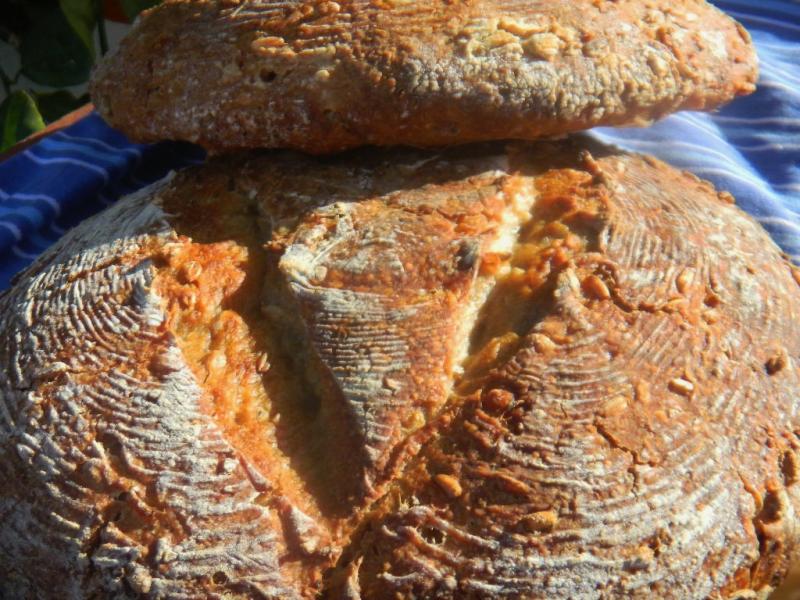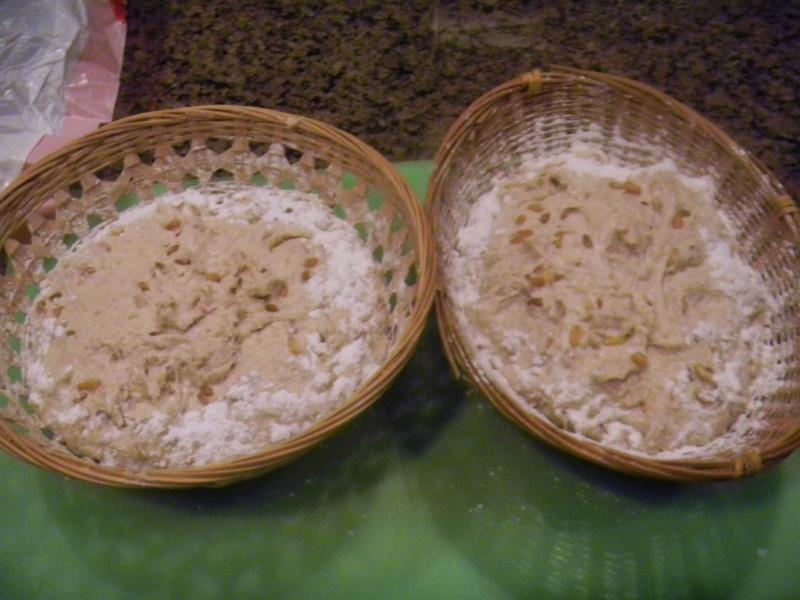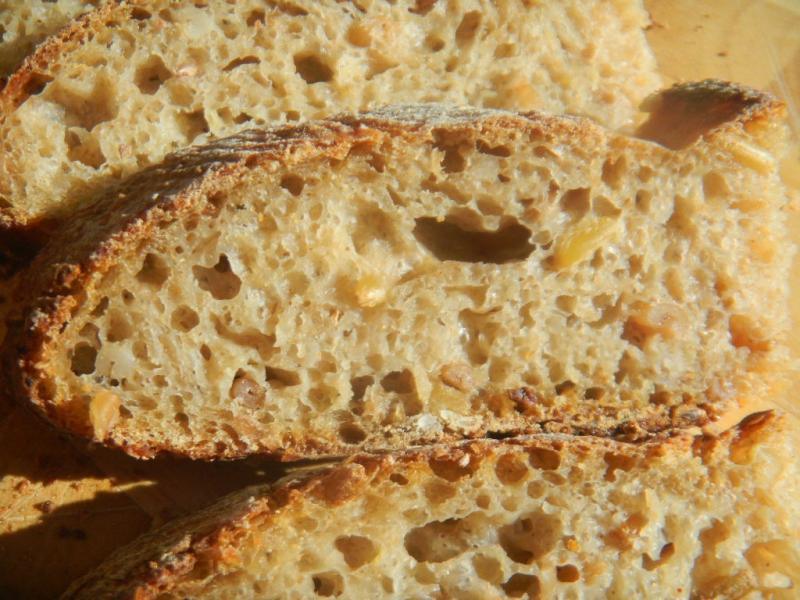This is the first bread bake in 2013 and we wanted to get back to our favorite every day bread type; a sourdough multi-grain with a multigrain scald or with multigrain sprouts or both. This time we use a scalded soaker and finally got around to putting some cream cheese in the mix ala Ian’s many breads with cheese.

2 days before dough mixing we got the 100% hydration levain going over two builds that took 12 hours and then it was retarded for 36 hours in the fridge
The day before the dough mixing, we scalded the multi-grain berries and set them aside to soak for 24 hours. We used a little more water than normal in hopes of having some left over soaker water that we could use for part of the liquid in the dough.


The night before dough mixing we strained off the soaker water, replacing it with fresh hot water, and used this along with additional water to autolyse the flours, potato flakes, malts, salt, Toady Tom’s and Tasty and Toasted Tidbits overnight on the 64 F counter.


The whole grain home ground flours included oats, rye, whole wheat spelt, Kamut, quinoa and barley. Home made red and white malts were used as was the new favorite flavor booster; TTTTT’s, a toasted mix of wheat bran, wheat germ, oat bran and sifted middling of various home ground flours.


Once the levain and autolyse came together in the mixing bowl and were hand mixed to incorporate the wet with the dry, we started French slap and folds. The gluten developed very well and after 10 minutes the 72% hydration dough was taught, smooth and glossy.


After a 15 minute rest in a covered, oiled bowl, the first of (3) S&F’s 15 minutes apart, was completed. The soaked grain berries were drained and dried with a paper towel and incorporated with the cream cheese on the 2nd S&F. By the 3rd S&F, the cream cheese and grain berries were evenly distributed and the dough was much looser and wet. It felt like about a 78% hydration dough.

The completed dough was allowed to ferment and develop on the counter for 1 hour before dividing into two loaves and pre-shaped into balls. The final shaping into boules happened 10 minutes later and the dough was placed seam side up into rice floured baskets.

The baskets were sealed into a nearly new, trash can liner and allowed to ferment and develop on the counter for 1 hour before being placed into the fridge for a long and low temperature 36 hour retard at 36 F.

No peaking was allowed but my apprentice did look at the 24 hour mark. After a peek she thought we should bake them off after letting them warm up but I decided to bake them off after the full 36 hours and bake them off cold instead.

We fired up old Betsy to500 Fand put our two favorite thick aluminum DO’s, the Magna Ware Oval Turkey Roaster with trivet insert and a great round Goodwill find, inside the beast to heat.
After 36 hours the dough looked over proofed by volume but, after poking it, the dough was so cold it didn’t know it was even being poked. I took this as a sign to get them in the DO’s very cold so they wouldn’t collapse.

I considered not slashing them at all to keep possible deflating disturbances to a minimum but finally did one with a single central slash and the other with a top mounted triangle. Both took a nose dive in height afterwards but we hoped they might recover in the oven.
Into the hot DO’s they went with a ¼ c of water and into the oven followed. We lowered the temperature to 450 F 2 minutes after the DO’s hit the oven and continued to steam them for a total of 20 minutes before taking the lids off and baking them at 425 F, convection this time, for 10 minutes rotating the DO’s ever 5 minutes.
At the 30 minute mark we took the bread out of the DO’s and finished the baking on the stone. This took another 10 minutes, rotating them every 5 minutes, before the inside temperature reached 205 F. They then rested on the stone with the oven off and door ajar for 10 minutes before being moved to the cooling rack.
The boules didn’t spring so much as spread. We expected this due to the over proofing but they did blister up, crack and brown deeply with a decent bloom. The crust was very crunchy crispy as it acme out of the oven and stayed more crispy than chewy as it cooled.
The crumb is open, moist, slightly glossy and soft. The cheese really helped out the crumb and it is one of the nicest ones we have baked for this kind of bread. It tastes terrific and will be one of favorite sandwich breads going forward.
We really like this bread and if the hydration was a little lower, say 68, before the soaker went in, we think it would have lifted more and spread less.
Formula | | | | |
Starter | Build 1 | Build 2 | Total | % |
SD Rye and White Starter | 20 | 0 | 20 | 2.77% |
Quinoa | 0 | 10 | 10 | 1.90% |
Barley | 0 | 10 | 10 | 1.90% |
WW | 0 | 10 | 10 | 1.90% |
Spelt | 0 | 10 | 10 | 1.90% |
Kamut | 0 | 10 | 10 | 1.90% |
Dark Rye | 0 | 10 | 10 | 1.90% |
AP | 60 | 65 | 125 | 23.76% |
Water | 60 | 125 | 185 | 35.17% |
Total Starter | 140 | 250 | 140 | 26.62% |
| | | | |
Starter | | | | |
Hydration | 100.00% | | | |
Levain % of Total | 26.90% | | | |
| | | | |
Dough Flour | | % | | |
Toady Tom's Tasty Toasted Tidbits | 20 | 3.80% | | |
Red Malt | 3 | 0.57% | | |
White Malt | 3 | 0.57% | | |
Quinoa | 10 | 1.90% | | |
Whole Wheat | 10 | 1.90% | | |
Dark Rye | 10 | 1.90% | | |
Spelt | 10 | 1.90% | | |
Barley | 10 | 1.90% | | |
Dark Rye | 10 | 1.90% | | |
Bread Flour | 200 | 38.02% | | |
Potato Flakes | 20 | 3.80% | | |
Oat Flour | 20 | 3.80% | | |
AP | 200 | 38.02% | | |
Dough Flour | 526 | 100.00% | | |
Salt | 12 | 1.66% | | |
Soaker Water | 330 | 62.74% | | |
Dough Hydration | 62.74% | | | |
| | | | |
Total Flour | 721 | | | |
Soaker Water 330 and Water 180 | 525 | | | |
Total Dough Hydration | 72.82% | | | |
| | | | |
Hydration w/ Adds | 72.82% | | | |
Total Weight | 1,450 | | | |
| | | | |
Whole Grains | 23.02% | | | |
| | | | |
Scald | | % | | |
WW | 20 | 3.80% | | |
Rye | 20 | 3.80% | | |
Quinoa | 20 | 3.80% | | |
Kamut | 20 | 3.80% | | |
Barley | 20 | 3.80% | | |
Spelt | 20 | 3.80% | | |
Total Scald | 120 | 22.81% | | |
| | | | |
Add - Ins | | % | | |
Cream Cheese | 72 | 13.69% | | |
Total | 72 | 13.69% | | |